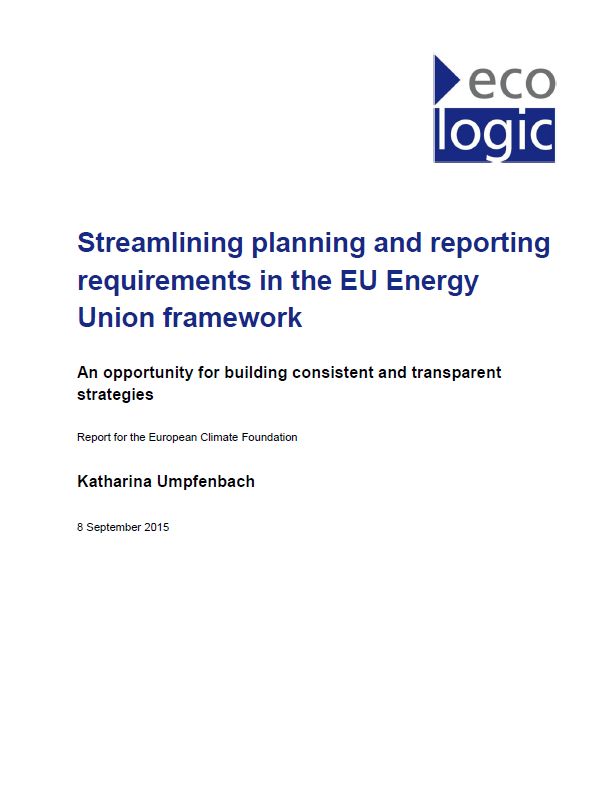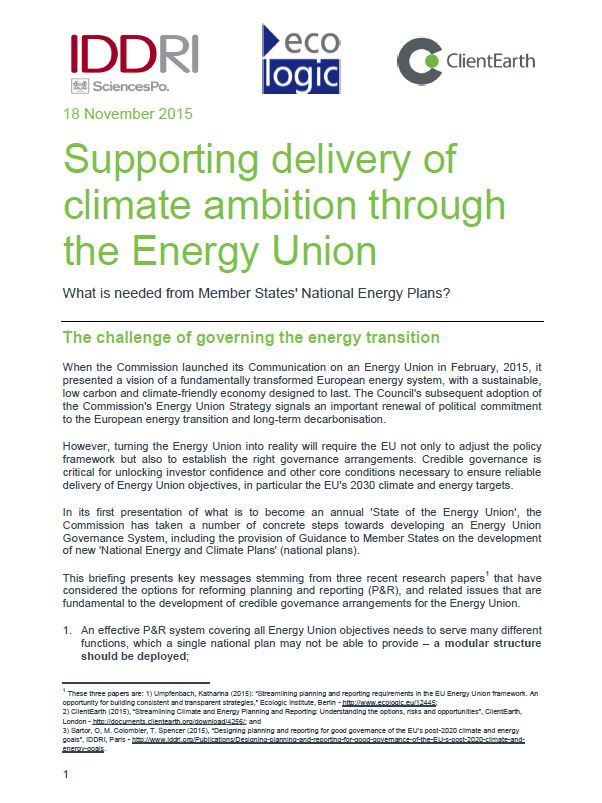Streamlining Planning and Reporting Requirements in the EU Energy Union Framework
An opportunity for building consistent and transparent strategies
- Publication
- Citation
Umpfenbach, Katharina (2015): Streamlining planning and reporting requirements in the EU Energy Union framework. An opportunity for building consistent and transparent strategies, Ecologic Institute, Berlin.
The EU is currently discussing two overlapping policy frameworks: The Climate and Energy Framework for 2020 to 2030 and the Energy Union strategy. As a key element of the reformed system, the EU intends to reduce administrative burden for member states by streamlining planning and reporting requirements. As a contribution to this debate, a new Ecologic Institute study assesses risks and opportunities of four concrete options. The study is available for download.
The study:
- takes stock of the existing planning and reporting regime in the Energy Union field up to 2020 in order to identify overlaps and gaps, and
- assesses opportunities and risks of four streamlining options based on criteria derived from overarching principles of good governance and from the expectations that member states and EU institutions have formulated for the new 2030 energy governance.
The study’s empirical foundation is an analysis of gaps, overlaps and inconsistencies in the existing planning and reporting regime. This analysis revealed that formalised mid-term planning requirements are restricted to the renewable energy and energy efficiency policy field as well as high-voltage grid planning. Strategic forward-looking planning at national level is missing for the greenhouse gas reduction and interconnection targets while a regional approach is dominant in the efforts for completing the internal energy market. Overlaps and duplications exist between the planning and reporting requirements under the Monitoring Mechanism Regulation, the Energy Efficiency Directive and the Renewable Energy Directive. Duplications concern the listing of policy measures and the deployed baseline scenarios for future greenhouse gas emissions and energy use. Overlaps also can also be detected between reporting on electricity market rules and grid reliability and the related requirements under the Renewable Energy Directive. As market and grid integration progresses, these overlaps are poised to grow. Similarly, new duplications could arise if EU security of supply legislation is extended to address the long-term resilience of the electricity sector and gas supplies.
Reflecting these results as well as evaluations of the existing system, the following options for streamlining the existing P&R regime were assessed:
- Energy Union strategies: Integration of the existing planning and reporting requirements for the full Energy Union portfolio into one plan and one report;
- Low-carbon strategies: Planning and reporting requirements based on the greenhouse gas reduction target integrating existing planning and reporting under ETS, ESD, MMR, RED, EED and in the field of LULUCF (while keeping reporting on the internal energy market and security of supply as separate reporting strands).
- Sustainable energy strategies: Integrating planning and reporting requirements for renewable energies and energy efficiency (while keeping separate reporting for greenhouse gas reductions, internal energy market and security of supply).
- Sector-specific strategies: Reorganising the existing planning and reporting under the Energy Union into five sector-specific plans and reports on electricity, transport, buildings, waste and industry and agriculture and land-use.
From the assessment of the four streamlining options presented in the table above, option 2 (low-carbon strategies) and option 4 (sector-specific strategies) emerge as the most promising approaches. By contrast, option 3 (sustainable energy strategies) misses most of the opportunities for improved coherence and option 1 (Energy Union strategies) risks to be either impractical – if the current level of detail is kept – or very superficial and therefore ineffective. Low-carbon strategies appear to be a promising approach for increasing coherence between the various P&R requirements developed under the 2020 climate and energy package while filling the gap of a strategic forward-planning on climate change mitigation. This option’s main drawback is that it would not reflect the increasing interlinkages with planning and reporting requirements under Internal Energy Market and Security of supply legislation. The sector-specific strategies proposed under option 4 would deliver exactly this type of integration, thereby proactively addressing the challenges of the next phase in the EU energy transition. Due to that reason the option also appears most suitable for integrating the planned additional legislation and strategies, e.g. on energy market design and security of supply in the electricity sector. The downside is the inherent risk that would come with such a drastic reorganisation of the existing planning and reporting regime. At least initially, administrative burden is also likely to be higher than for the low-carbon strategies.
A potential way for combining the respective benefits of the most promising options with of the idea an overarching Energy Union reporting mechanism would be a modular approach. Thereby, national governments would produce a high-level, annual report on all five dimensions of the Energy Union strategy, followed by Commission review and recommendations. This report would however not replace the existing issue-specific plans and reports, but streamlined low-carbon strategies or sector-specific strategies would – like chapters to a summary – underpin the high-level report with detailed data and information.





